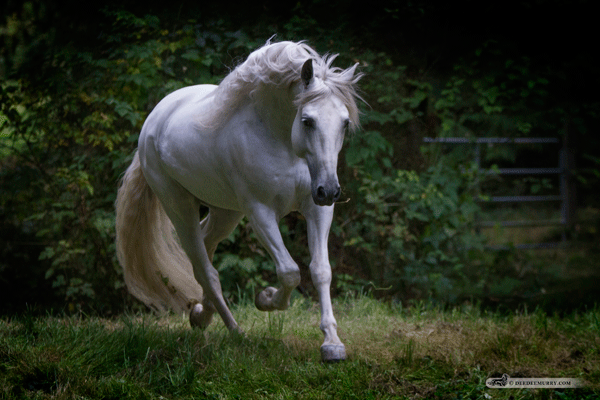
I’m looking to buy an Andalusian and have found a beautiful 5-year-old mare who looks almost picture-book perfect. I noticed, however, that she has a rather short back and croup. Will this in any way hinder her development as a dressage horse? I have always thought a more rectangular horse is more suitable for dressage. What is your opinion? What are you looking for when choosing an Andalusian for dressage?
Mario Contreras:
When picking out a dressage horse, it is important that you pay special attention to the personality and temperament of the horse. Even if the horse has the best conformation in the world and has bloodlines that are screaming with talent—if you and the horse have a personality conflict (e.g., if the horse is extremely hot or spooky and you are a timid rider), it will not paint the pretty picture of perfection that is dressage.
To address the specific question of Andalusians as dressage prospects: I believe that this particular breed has a lot of qualities that allow it to be competitive at dressage. Overall, Andalusians have fantastic personalities and are very quick learners. Their naturally fluid gaits and expressive movement make them a pleasure to work with.
To find an Andalusian that is best suited for dressage, remember that your horse needs a conformation that will support suppleness, balance and strength. A higher-level dressage horse must show suspension, cadence and elevation while being relaxed, submissive and supple to your aids. Most of these criteria require the horse’s hindquarters to be a powerhouse. The horse also needs to be sound and strong with long femur bones, have a correct angulation of the hock joints—90 degrees—and his hocks must be under his body. This allows the horse to be able to step underneath himself more easily. If the hocks are too close together, the horse will have difficulty carrying weight, and too much angle in the hocks will create soreness in his hindquarters. The horse’s croup should be elongated and slightly slanted, which will allow him to drop down and create lightness on his forehand. By “dropping down” I mean that the horse will lower his hindquarters and engage the muscles in his hind end, which gives him the power and balance to perform the higher-level movements as well as execute any basic movements with more expression and correctness. When more weight is put on the hindquarters, the shoulders of the horse can move freely and stretch out in front of him.
The horse’s neck and back should be what I consider average in length and proportionate to the rest of his body. A back that is too long makes it hard for the horse to do lateral movements evenly and it puts the rider in an unsupported section of the horse. If the back is too short, on the other hand, saddle-fitting will be an issue, and it’s much more likely that the saddle placement will block the horse’s shoulders. A horse that is more compact and correctly balanced over his back will be able to manage all parts of his body with more ease. If his hips are too far away from his shoulders, it becomes increasingly difficult for him to be coordinated and able to isolate one group of muscles at a time. This is something that can be worked on over time, but for a young horse this will create more work for the rider.
The front end of the horse should consist of a sloping shoulder with a matching slope to the pastern. This will allow the horse to be able to stay light on his forehand and rock back onto his hindquarters. The forelimbs should be straight and the humerus (arm) bone should be on the longer side to allow the horse’s elbow to swing away from his shoulder—forward or sideways—in lateral movements and extended gaits. Be sure there is no paddling or toeing out of the front feet when the horse moves.
It is very important that you either ask your trainer or someone whose opinion you trust to go with you to look at a horse. There are a lot of things that can be seen from the ground that this person can be watching for while you ride the horse and vice versa. Your trainer can tell you how the horse feels while he is riding and he can tell you how that coincides with what he sees from the ground. It is also very important to have a vet available to do X-rays and flexion diagnostics. The more thorough you can be about the overall well-being and structural soundness of the horse you are looking at, the more certain you can be that the two of you will have a long and successful partnership.
In conclusion, you want your horse to be able to do his job with as little effort as possible. The correct conformation of a horse is what allows this to happen. Three simple things to remember are: The horse is sound and powerful, all aspects of the horse are proportionate and you are able to form a positive relationship with the horse that you choose.
Ready to look for the right horse for you? Go to Equine.com, the premier classifieds site of the Equine Network, to search for the perfect horse!











